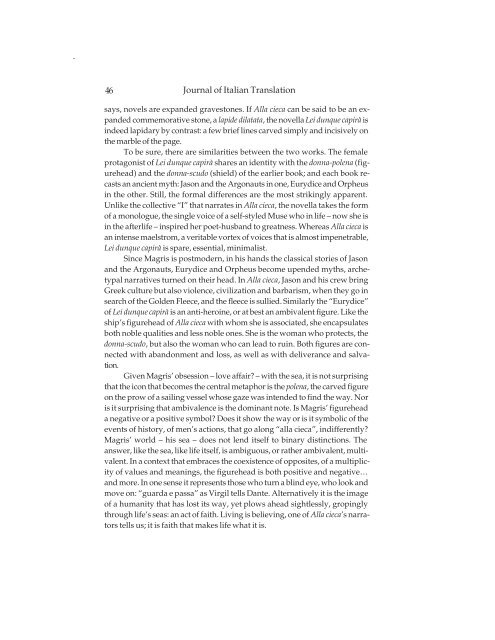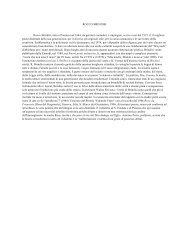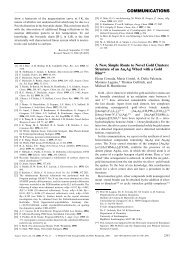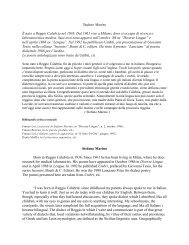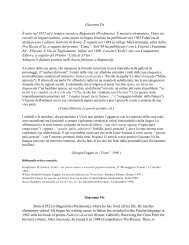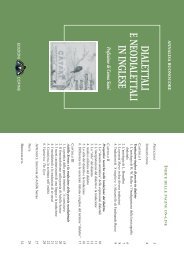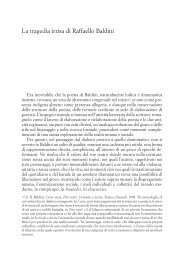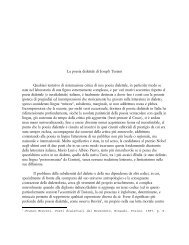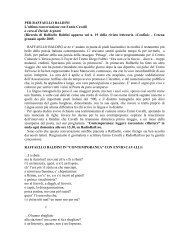Journal of Italian Translation
Journal of Italian Translation
Journal of Italian Translation
You also want an ePaper? Increase the reach of your titles
YUMPU automatically turns print PDFs into web optimized ePapers that Google loves.
46 <strong>Journal</strong> <strong>of</strong> <strong>Italian</strong> <strong>Translation</strong><br />
says, novels are expanded gravestones. If Alla cieca can be said to be an expanded<br />
commemorative stone, a lapide dilatata, the novella Lei dunque capirà is<br />
indeed lapidary by contrast: a few brief lines carved simply and incisively on<br />
the marble <strong>of</strong> the page.<br />
To be sure, there are similarities between the two works. The female<br />
protagonist <strong>of</strong> Lei dunque capirà shares an identity with the donna-polena (figurehead)<br />
and the donna-scudo (shield) <strong>of</strong> the earlier book; and each book recasts<br />
an ancient myth: Jason and the Argonauts in one, Eurydice and Orpheus<br />
in the other. Still, the formal differences are the most strikingly apparent.<br />
Unlike the collective “I” that narrates in Alla cieca, the novella takes the form<br />
<strong>of</strong> a monologue, the single voice <strong>of</strong> a self-styled Muse who in life – now she is<br />
in the afterlife – inspired her poet-husband to greatness. Whereas Alla cieca is<br />
an intense maelstrom, a veritable vortex <strong>of</strong> voices that is almost impenetrable,<br />
Lei dunque capirà is spare, essential, minimalist.<br />
Since Magris is postmodern, in his hands the classical stories <strong>of</strong> Jason<br />
and the Argonauts, Eurydice and Orpheus become upended myths, archetypal<br />
narratives turned on their head. In Alla cieca, Jason and his crew bring<br />
Greek culture but also violence, civilization and barbarism, when they go in<br />
search <strong>of</strong> the Golden Fleece, and the fleece is sullied. Similarly the “Eurydice”<br />
<strong>of</strong> Lei dunque capirà is an anti-heroine, or at best an ambivalent figure. Like the<br />
ship’s figurehead <strong>of</strong> Alla cieca with whom she is associated, she encapsulates<br />
both noble qualities and less noble ones. She is the woman who protects, the<br />
donna-scudo, but also the woman who can lead to ruin. Both figures are connected<br />
with abandonment and loss, as well as with deliverance and salvation.<br />
Given Magris’ obsession – love affair? – with the sea, it is not surprising<br />
that the icon that becomes the central metaphor is the polena, the carved figure<br />
on the prow <strong>of</strong> a sailing vessel whose gaze was intended to find the way. Nor<br />
is it surprising that ambivalence is the dominant note. Is Magris’ figurehead<br />
a negative or a positive symbol? Does it show the way or is it symbolic <strong>of</strong> the<br />
events <strong>of</strong> history, <strong>of</strong> men’s actions, that go along “alla cieca”, indifferently?<br />
Magris’ world – his sea – does not lend itself to binary distinctions. The<br />
answer, like the sea, like life itself, is ambiguous, or rather ambivalent, multi-<br />
valent. In a context that embraces the coexistence <strong>of</strong> opposites, <strong>of</strong> a multiplicity<br />
<strong>of</strong> values and meanings, the figurehead is both positive and negative…<br />
and more. In one sense it represents those who turn a blind eye, who look and<br />
move on: “guarda e passa” as Virgil tells Dante. Alternatively it is the image<br />
<strong>of</strong> a humanity that has lost its way, yet plows ahead sightlessly, gropingly<br />
through life’s seas: an act <strong>of</strong> faith. Living is believing, one <strong>of</strong> Alla cieca’s narrators<br />
tells us; it is faith that makes life what it is.


